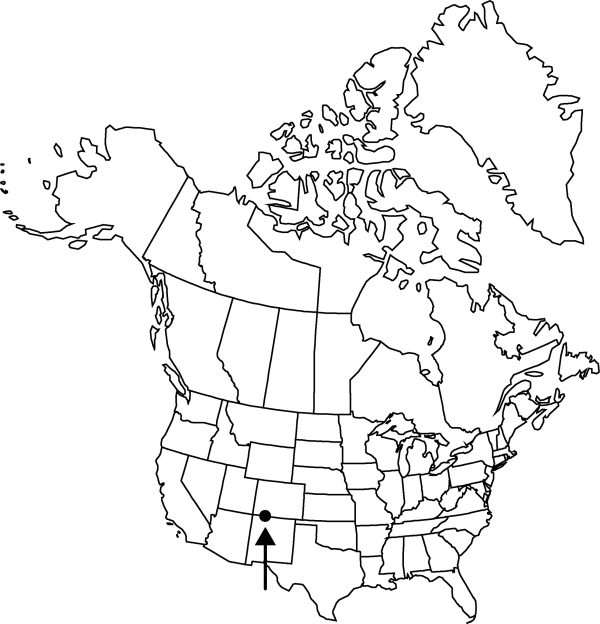Difference between revisions of "Pediocactus knowltonii"
Cact. Succ. J. (Los Angeles) 32: 193. 1960.
FNA>Volume Importer |
imported>Volume Importer |
||
| (7 intermediate revisions by 2 users not shown) | |||
| Line 8: | Line 8: | ||
}} | }} | ||
|common_names=Knowlton’s minute cactus | |common_names=Knowlton’s minute cactus | ||
| + | |special_status={{Treatment/ID/Special_status | ||
| + | |code=E | ||
| + | |label=Endemic | ||
| + | }}{{Treatment/ID/Special_status | ||
| + | |code=C | ||
| + | |label=Conservation concern | ||
| + | }} | ||
|basionyms= | |basionyms= | ||
|synonyms={{Treatment/ID/Synonym | |synonyms={{Treatment/ID/Synonym | ||
|name=Pediocactus bradyi var. knowltonii | |name=Pediocactus bradyi var. knowltonii | ||
|authority=(L. D. Benson) Backeberg | |authority=(L. D. Benson) Backeberg | ||
| − | }}{{Treatment/ID/Synonym | + | |rank=variety |
| + | }} {{Treatment/ID/Synonym | ||
|name=Pediocactus simpsonii var. knowltonii | |name=Pediocactus simpsonii var. knowltonii | ||
|authority=(L. D. Benson) Halda | |authority=(L. D. Benson) Halda | ||
| + | |rank=variety | ||
}} | }} | ||
|hierarchy=Cactaceae;Cactaceae subfam. Cactoideae;Pediocactus;Pediocactus knowltonii | |hierarchy=Cactaceae;Cactaceae subfam. Cactoideae;Pediocactus;Pediocactus knowltonii | ||
| Line 23: | Line 32: | ||
}}<!-- | }}<!-- | ||
| − | --><span class="statement" id="st- | + | --><span class="statement" id="st-undefined" data-properties=""><b>Plants </b>branched or unbranched. <b>Stems</b> globular to short cylindric, 0.7–5.5 × 1–3 cm; areoles circular, villous. <b>Spines</b> smooth, relatively hard, all radial, mostly 18–26 per areole, spreading, recurved, or somewhat pectinate, reddish tan, pink, or white, 1–1.5 mm, canescent. <b>Flowers</b> 1–3.5 × 1–2.5 cm; scales and outer tepals essentially entire, often undulate; outer tepals with brownish midstripes to 1.5 mm wide, 4–17 × 4–6 mm; inner tepals pink, oblanceolate, 8–25 × 3–8 mm. <b>Fruits</b> green, drying reddish tan, turbinate,4 × 3 mm. <b>Seeds</b> black, 1.5 × 1–1.2 mm, papillate but not rugose.</span><!-- |
-->{{Treatment/Body | -->{{Treatment/Body | ||
| + | |phenology=Flowering spring. | ||
|habitat=Gravel pavements in pinyon-juniper woodlands with mixed sagebrush | |habitat=Gravel pavements in pinyon-juniper woodlands with mixed sagebrush | ||
|elevation=2000 m | |elevation=2000 m | ||
|distribution=N.Mex. | |distribution=N.Mex. | ||
|discussion=<p>Of conservation concern.</p><!-- | |discussion=<p>Of conservation concern.</p><!-- | ||
| − | --><p>Pediocactus knowltonii is the smallest and rarest member of the genus. The species is very closely related to P. simpsonii; chloroplast DNA sequence analysis provides support that it represents a recent developmental mutation within P. simpsonii (J. M. Porter et al. unpubl.).</p> | + | --><p><i>Pediocactus knowltonii</i> is the smallest and rarest member of the genus. The species is very closely related to <i>P. simpsonii</i>; chloroplast DNA sequence analysis provides support that it represents a recent developmental mutation within <i>P. simpsonii</i> (J. M. Porter et al. unpubl.).</p> |
|tables= | |tables= | ||
|references= | |references= | ||
| Line 39: | Line 49: | ||
-->{{#Taxon: | -->{{#Taxon: | ||
name=Pediocactus knowltonii | name=Pediocactus knowltonii | ||
| − | |||
|authority=L. D. Benson | |authority=L. D. Benson | ||
|rank=species | |rank=species | ||
| Line 46: | Line 55: | ||
|basionyms= | |basionyms= | ||
|family=Cactaceae | |family=Cactaceae | ||
| + | |phenology=Flowering spring. | ||
|habitat=Gravel pavements in pinyon-juniper woodlands with mixed sagebrush | |habitat=Gravel pavements in pinyon-juniper woodlands with mixed sagebrush | ||
|elevation=2000 m | |elevation=2000 m | ||
| Line 52: | Line 62: | ||
|publication title=Cact. Succ. J. (Los Angeles) | |publication title=Cact. Succ. J. (Los Angeles) | ||
|publication year=1960 | |publication year=1960 | ||
| − | |special status= | + | |special status=Endemic;Conservation concern |
| − | |source xml=https:// | + | |source xml=https://bitbucket.org/aafc-mbb/fna-data-curation/src/2e0870ddd59836b60bcf96646a41e87ea5a5943a/coarse_grained_fna_xml/V4/V4_402.xml |
|subfamily=Cactaceae subfam. Cactoideae | |subfamily=Cactaceae subfam. Cactoideae | ||
|genus=Pediocactus | |genus=Pediocactus | ||
|species=Pediocactus knowltonii | |species=Pediocactus knowltonii | ||
| − | |||
| − | |||
| − | |||
| − | |||
| − | |||
| − | |||
| − | |||
| − | |||
| − | |||
| − | |||
| − | |||
| − | |||
| − | |||
| − | |||
| − | |||
| − | |||
| − | |||
| − | |||
| − | |||
| − | |||
| − | |||
| − | |||
| − | |||
| − | |||
| − | |||
| − | |||
| − | |||
| − | |||
| − | |||
| − | |||
| − | |||
| − | |||
| − | |||
| − | |||
| − | |||
| − | |||
| − | |||
| − | |||
}}<!-- | }}<!-- | ||
-->[[Category:Treatment]][[Category:Pediocactus]] | -->[[Category:Treatment]][[Category:Pediocactus]] | ||
Latest revision as of 22:58, 5 November 2020
Plants branched or unbranched. Stems globular to short cylindric, 0.7–5.5 × 1–3 cm; areoles circular, villous. Spines smooth, relatively hard, all radial, mostly 18–26 per areole, spreading, recurved, or somewhat pectinate, reddish tan, pink, or white, 1–1.5 mm, canescent. Flowers 1–3.5 × 1–2.5 cm; scales and outer tepals essentially entire, often undulate; outer tepals with brownish midstripes to 1.5 mm wide, 4–17 × 4–6 mm; inner tepals pink, oblanceolate, 8–25 × 3–8 mm. Fruits green, drying reddish tan, turbinate,4 × 3 mm. Seeds black, 1.5 × 1–1.2 mm, papillate but not rugose.
Phenology: Flowering spring.
Habitat: Gravel pavements in pinyon-juniper woodlands with mixed sagebrush
Elevation: 2000 m
Discussion
Of conservation concern.
Pediocactus knowltonii is the smallest and rarest member of the genus. The species is very closely related to P. simpsonii; chloroplast DNA sequence analysis provides support that it represents a recent developmental mutation within P. simpsonii (J. M. Porter et al. unpubl.).
Selected References
None.
